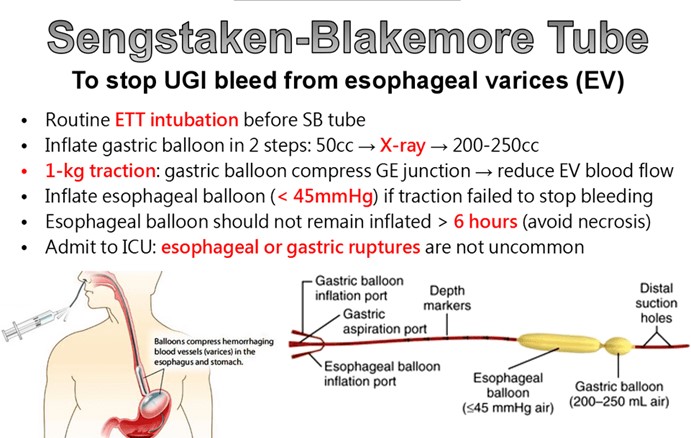A nurse is caring for a client who has bleeding esophageal varices and is being treated with a Sengstaken-Blakemore tube. Which of the following actions should the nurse perform?
Deflate the balloons for 5 min every 2 hr to prevent tissue necrosis.
Keep the head of the bed flat at all times to prevent the development of shock.
Maintain constant observation while the balloons are inflated.
Suction the tube every 2 hr and as needed to maintain patency.
The Correct Answer is C
Choice A Reason: This is incorrect. The balloons should not be deflated without a physician's order, as this can cause rebleeding or aspiration.
Choice B Reason: This is incorrect. The head of the bed should be elevated to 30 to 45 degrees to reduce pressure on the balloons and prevent gastric reflux.
Choice C Reason: This is correct. The nurse should monitor the client closely for signs of complications, such as airway obstruction, aspiration, or balloon rupture. The nurse should also keep scissors at the bedside to cut the tube and release the balloons in case of an emergency.
Choice D Reason: This is incorrect. The tube should not be suctioned, as this can damage the mucosa and cause bleeding. The nurse should only aspirate gastric contents through the gastric lumen to decompress the stomach.

Nursing Test Bank
Naxlex Comprehensive Predictor Exams
Related Questions
Correct Answer is B
Explanation
Choice A Reason: This is incorrect. Flushing of the skin is not a sign of hypovolemic shock, but rather of vasodilation or fever. Hypovolemic shock causes vasoconstriction and pale, cool, clammy skin.
Choice B Reason: This is correct. Oliguria is a decreased urine output that indicates reduced renal perfusion due to hypovolemia. The normal urine output for an adult is 0.5 to 1 mL/kg/hr.
Choice C Reason: This is incorrect. Hypertension is not a sign of hypovolemic shock, but rather of increased vascular resistance or fluid overload. Hypovolemic shock causes hypotension due to decreased blood volume and cardiac output.
Choice D Reason: This is incorrect. Bradypnea is a slow respiratory rate that indicates respiratory depression or fatigue. Hypovolemic shock causes tachypnea due to hypoxia and increased metabolic demand.
Correct Answer is B
Explanation
Choice a) is incorrect because calcium levels are not directly affected by hemodialysis. Calcium is a mineral that is important for bone health, blood clotting, and muscle contraction. Hemodialysis does not remove calcium from the blood, but it may cause low calcium levels if the dialysate fluid has a lower concentration of calcium than the blood.
Choice b) is correct because potassium levels are decreased by hemodialysis. Potassium is an electrolyte that is essential for nerve and muscle function, especially the heart. Hemodialysis removes excess potassium from the blood, which can build up in people with kidney failure and cause irregular heartbeats, muscle weakness, or even cardiac arrest.
Choice c) is incorrect because protein levels are not decreased by hemodialysis. Protein is a macromolecule that is composed of amino acids and performs various functions in the body, such as building and repairing tissues, transporting substances, and regulating processes. Hemodialysis does not remove protein from the blood, but it may cause low protein levels if the client has a poor diet or loses protein through other means, such as urine or wounds.
Choice d) is incorrect because RBC count is not decreased by hemodialysis. RBCs are red blood cells that carry oxygen throughout the body. Hemodialysis does not remove RBCs from the blood, but it may cause low RBC count if the client has anemia, which is a common complication of kidney failure. Anemia can be caused by reduced production of erythropoietin (a hormone that stimulates RBC production), iron deficiency, or blood loss.
Whether you are a student looking to ace your exams or a practicing nurse seeking to enhance your expertise , our nursing education contents will empower you with the confidence and competence to make a difference in the lives of patients and become a respected leader in the healthcare field.
Visit Naxlex, invest in your future and unlock endless possibilities with our unparalleled nursing education contents today
Report Wrong Answer on the Current Question
Do you disagree with the answer? If yes, what is your expected answer? Explain.
Kindly be descriptive with the issue you are facing.
